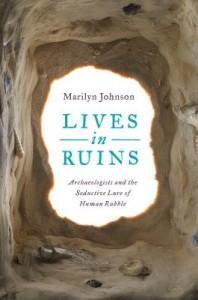Title: Lives in Ruins: Archaeologists and the Seductive Lure of Human Rubble
Author: Marilyn Johnson
ISBN: 9780062127181
No. of Pages: 288
Genre: Nonfiction
Origins: Harper Books
Release Date: 11 November 2014
Bottom Line: Truly excellent
 Synopsis:
Synopsis:
“Pompeii, Machu Picchu, the Valley of the Kings, the Parthenon—the names of these legendary archaeological sites conjure up romance and mystery. The news is full of archaeology: treasures found (British king under parking lot) and treasures lost (looters, bulldozers, natural disaster, and war). Archaeological research tantalizes us with possibilities (are modern humans really part Neandertal?). Where are the archaeologists behind these stories? What kind of work do they actually do, and why does it matter?
Marilyn Johnson’s Lives in Ruins is an absorbing and entertaining look at the lives of contemporary archaeologists as they sweat under the sun for clues to the puzzle of our past. Johnson digs and drinks alongside archaeologists, chases them through the Mediterranean, the Caribbean, and even Machu Picchu, and excavates their lives. Her subjects share stories we rarely read in history books, about slaves and Ice Age hunters, ordinary soldiers of the American Revolution, children of the first century, Chinese woman warriors, sunken fleets, mummies.
What drives these archaeologists is not the money (meager) or the jobs (scarce) or the working conditions (dangerous), but their passion for the stories that would otherwise be buried and lost.”
Thoughts: For better or for worse, the study of archeology will forever evoke images of a sweaty Harrison Ford in his iconic leather jacket and fedora battling Nazis, snakes, and other bad guys for all sorts of unusual and often valuable historical artifacts. However, what Indiana Jones does in the field is practically a cakewalk compared to the daily battles modern archaeologists must fight. Lives in Ruins brings the focus away from the idea of swashbuckling archeology and presents the field of study as it truly is.
As Ms. Johnson discovers during her research and as she humorously presents to readers, true archeology is backbreaking work. Often, it means working in subpar conditions, fighting against time, weather, curiosity, greed, politics, and a severe lack of funding. Indeed, this lack of money is the common theme throughout the book. In fact, almost all of her research subjects do not earn a living wage. There are almost no permanent jobs, and funding for expeditions and for storage of the finds is quickly running dry. The story Ms. Johnson tells over and over is that no one will ever make money working in the field of archeology.
While this may seem like a rather depressing thread about which to read, what Ms. Johnson does so well is capture the dedication and passion these scientists have for their chosen profession. Each scientist she interviews exhibits a fierce pride in their area of expertise and a complete unwillingness to walk away to move to a more lucrative field. They thrive under the stress and strain of such work and do so with smiles on their faces. Theirs is truly a labor of love.
They may work under the most dire of situations, but all of Ms. Johnson’s subjects maintain an amazing sense of humor about those self-same situations. Each one recognizes the endless work and time limits nature places on artifacts. They understand that luck is as much a part of a career-making find as it is perseverance and skill. They use humor to repeatedly pick themselves up after each disappointment. This is something about which Ms. Johnson is quick to capitalize. She injects her own sense of fun and humor into her reporting, layering it on to the individual quirks of her subjects to create a book that is much more hopeful than one might think given the immense odds that come with archeology.
Lives in Ruins dispels the myth created by Steven Spielberg all those years ago, but one finishes the book with the understanding that the archaeologists of today are the true heroes of this tale. For, they work because they love it. They love it so much in fact that they are willing to put up with the scarcity of resources and political battles and flirt dangerously close to the poverty line for most of their lives in order to fulfill their dreams. It is as powerful an example as one will ever get of working for love and not for money.
